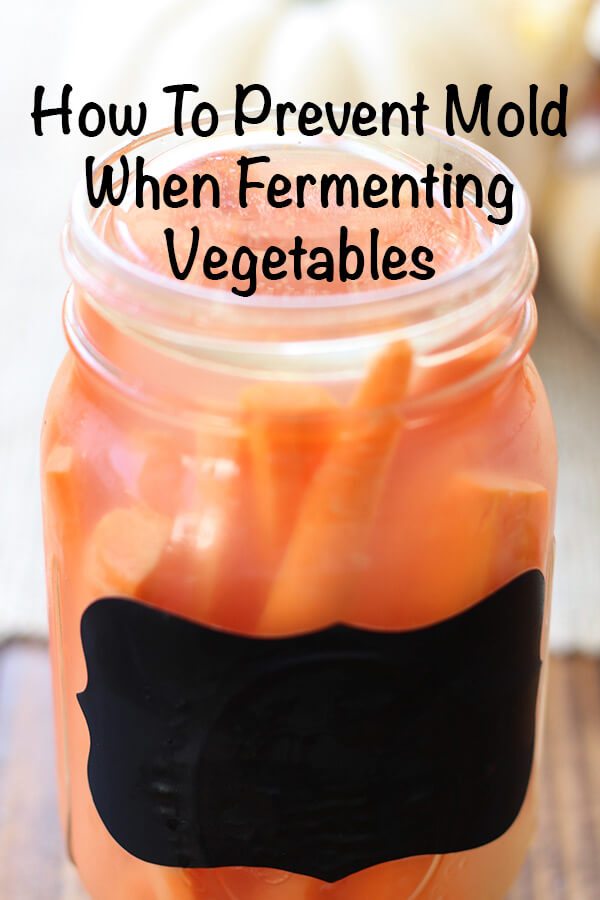When mold shows up in your fermented veggies it can be really scary and gross. It happens to all of us at some point and it’s happened to me many times. I’ve learned how to prevent mold when fermenting veggies over the years and since I get this concern and question all the time, here’s how I do it.
What’s mold
Mold can be round and fuzzy, blue, black or pink and can appear on the surface of your ferment. It can form when the ferment is exposed to air, if the salt ratio is wrong, if the vegetables and tools aren’t clean, if you use chlorinated water, and other things.
There are some pictures of mold growing on pickles in this article by the Fermentation Podcast.
Don’t get mold confused with kahm yeast which looks like a white milky film. Read about Kahm yeast here.
What to do if you have mold
There are many opinions on what to do if mold forms on your ferment. Some people are really sensitive to mold and should avoid it completely, while it doesn’t affect others.
This is what I do about mold
If there are small amounts of mold forming on pieces of vegetables that are sticking out of the brine, I just throw those pieces away. If a third or more of the surface brine is covered in mold, I throw the whole thing away, because it grosses me out.
Some fermenters will skim it off the top and eat what’s under the brine. Everything under the brine is fine in theory, but if you’re sensitive to mold, throw it out. It’s not worth the risk.
If mold forms inside the fermentation jar, don’t eat it. Something is wrong with it.
More needs to be studied to provide a definitive answer, so go with what your most comfortable with. There are ways to prevent mold so you don’t have to make the decision.
How To Prevent mold when fermenting vegetables
1. Use fresh ingredients
Don’t use old, soggy cabbage or vegetables for your ferments. At this point they already started rotting on their own and could cause mold.
2. Maintain good hygiene
Clean your vegetables. Wash your tools and hands with hot, soapy water before use.
3. Use the exact amount of salt the recipe calls for
Some people are concerned about salt content, but it’s extremely important to create an environment that is inhospitable for harmful bacteria to survive. All my recipes are tested and use the right amount of salt for safe fermentation without being too salty.
4. Salt distribution
Make sure salt is evenly distributed in the cabbage when making sauerkraut. When making pickles make sure salt is completely dissolved in the brine.
5. Do not use iodized salt or table salt
Table salt has additives that can make the ferment go bad. I recommend fine high quality sea salt.
6. Purified water
Make sure to always use either distilled or purified water when fermenting vegetables. Tap water contains chemicals like chlorine that harm good bacteria, which could lead to a bad ferment.
7. Keep veggies submerged under the brine
The brine creates an environment that’s inhospitable to bad bacteria, so everything under the brine is fine. Mold shouldn’t form under the brine if you used the right salt ratio. I explain different methods of keeping veggies submerged here.
8. If you don’t use a weight to keep veggies submerged…
Stir the surface of the fermented vegetables daily to prevent mold from forming on the surface. Or push vegetables that are sticking out of the brine back down. Sometimes I just close the lid tight and shake them up each day. It does the trick.
9. Use a jar with an airlock lid
Airlock lids are designed to prevent air from entering the jar and inhibit mold. You can get them here. Use them with fermentation weights to be extra safe. My favorite are pickle pipes used with pickle pebbles. They are really easy to use. You can get those here.
Your mold problems should disappear if you follow these tips. If you want to learn more about fermentation, including step-by-step instructions on making your own healing, probiotic food, get my new ebook, “Fermenting Veggies” here.
Happy Fermenting!
Danielle

Thank you, thank you!!
I’m just beginning to play with fermenting, and I’m trying to educate myself about the dos and don’ts. I appreciate the time you’ve taken to help in this process!!